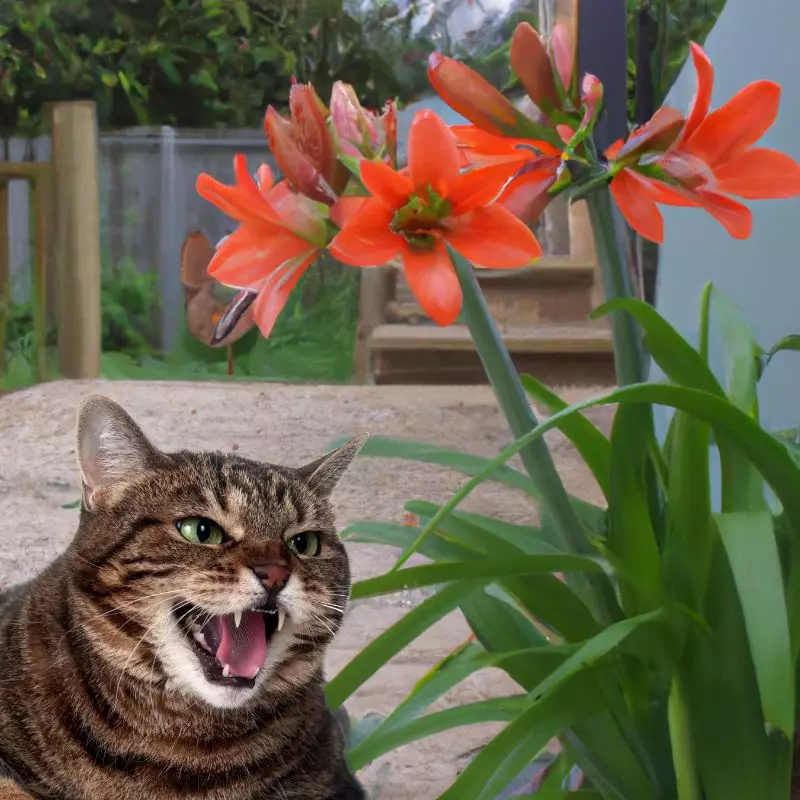Yes, Ridderstjerne is indeed toxic to cats. Lycorine, galanthamine, tazzetine, hippeastrine, and haemanthamine are the principal alkaloids and phytochemicals permeating the ridderstjerne plant, and they pose severe risks to cats. Exposure can lead to gastrointestinal discomfort and, in grave situations, can disrupt the central nervous system. The alkaloids influence protein synthesis, the critical process by which cells construct essential proteins; if interfered with, this can result in substantial health repercussions.
This article is crafted in collaboration with a group of seasoned Doctors of Veterinary Medicine (DVMs). Their extensive knowledge and experience have been instrumental in ensuring the provision of accurate, reliable, and current information on the risks associated with Ridderstjerne, detailing its adverse effects on cats. Our aim is to deliver the most precise details, validated by authoritative sources like the ASPCA and PetMD, to safeguard the well-being of your feline friends. Every plant discussed, including Ridderstjerne, has been meticulously researched on reputable websites to provide comprehensive insights into their potential toxicity to cats.
Clinical Signs of Ridderstjerne Poisoning in Cats

When a cat comes into contact with, inhales the scent of, or consumes the Ridderstjerne plant, it may exhibit a series of clinical signs indicative of poisoning due to the toxic alkaloids and phytochemicals present in the plant. Here is a detailed exploration of each sign and the underlying causes:
- Nausea and Vomiting: The ingestion of Ridderstjerne often leads to intense gastrointestinal irritation, causing nausea and subsequent vomiting, as the body attempts to expel the ingested toxins.
- Diarrhea: The toxic compounds in the plant disrupt the normal functioning of the gastrointestinal system, leading to increased bowel movements and diarrhea.
- Excessive Drooling: Contact with or consumption of the plant induces excessive salivation, a body’s reflexive response to rid itself of harmful substances.
- Loss of Appetite: The discomfort and pain associated with gastrointestinal irritation often result in a decreased desire to eat.
- Abdominal Pain: The irritation of the digestive tract due to the plant’s toxins results in abdominal discomfort or pain.
- Lethargy: The cat’s body, while combating the toxins, diverts energy, leading to decreased activity and lethargy.
- Low Blood Pressure: The toxic elements in Ridderstjerne can affect the cardiovascular system, causing a reduction in blood pressure.
- Cardiac Arrhythmias: The toxins can disrupt the normal electrical activity of the heart, leading to irregular heart rhythms or arrhythmias.
- Tremors: The effect of toxins on the nervous system can induce involuntary muscle movements or tremors as the body reacts to the intrusion.
- Convulsions: In severe cases, the disruption of the central nervous system can lead to sudden, violent, and irregular contractions of the muscles, causing convulsions.
- Paralysis: The severe impact on the nervous system may lead to a loss of muscle function, resulting in paralysis.
- Collapse: The culmination of severe symptoms such as low blood pressure and paralysis can lead to the sudden collapse of the affected cat.
Each of these symptoms can manifest due to the toxic impact of Ridderstjerne on a cat’s system and should be treated immediately and seriously. The severe central nervous system symptoms, in particular, are medical emergencies and warrant immediate veterinary attention. Always act promptly to ensure the safety and well-being of your pet, and seek veterinary advice even if the signs are seemingly mild, as early intervention is crucial in managing poisoning cases.
First Aid and Treatment of Poisoning Ridderstjerne in Cats

In cats, there is no specific antidote for ridderstjerne poisoning. As a result, treatment usually focuses on alleviating symptoms while also supporting the cat’s important organ function.
By eliminating all residual plant material before it is digested, pumping the cat’s stomach can help. Only in the most serious cases of poisoning is this done. If the plant has just been taken for a brief time, the vet may decide to provide activated charcoal.
Intravenous fluids and electrolytes may be given if the cat has become dehydrated due to a prolonged period of vomiting. Throughout the incident, the cat’s blood pressure and liver function should be checked.
Recovery from Ridderstjerne Poisoning in Cats

Most cats recover completely from ridderstjerne poisoning, as significant amounts of the plant are rarely consumed due to its unpleasant taste. As long as the liver remained functional during the disease, there should be no long-term health consequences.
Prevention of Ridderstjerne Poisoning in Cats
If you have ridderstjerne in your home, make sure it’s out of reach of your cat. To be safe, some people may choose not to keep this plant indoors. It’s possible that removing this plant from your garden will keep outdoor cats from eating it. The only method to truly secure your cat is to keep it indoors, where you can keep track of which plants it can get into. Getting a cat its own safe plant to chew on has been found to dissuade cats from sampling other houseplants.
If you love plants but have cats at home, check out these lists:





